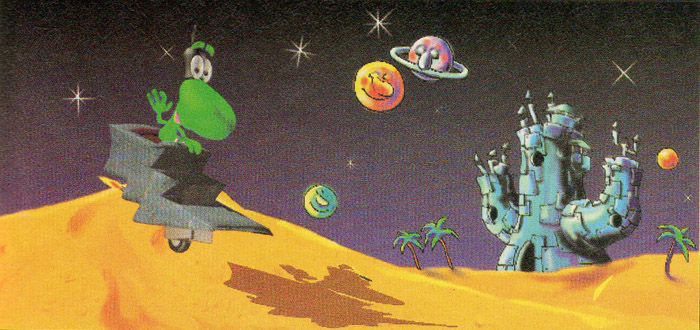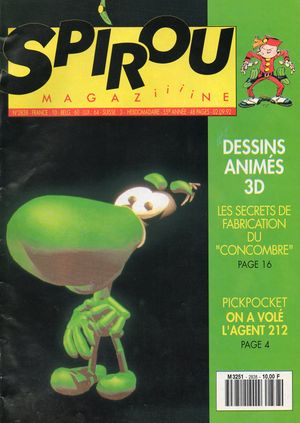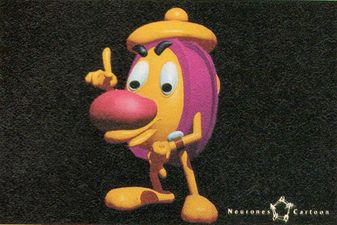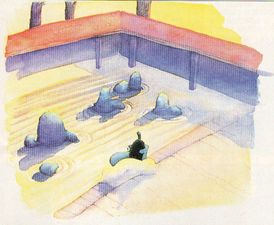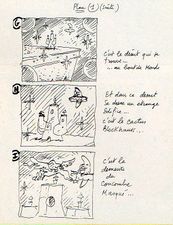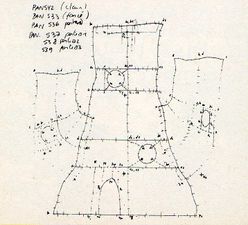The Lone Cuke (partially found CGI animated short based on French comic; 1993)
The Lone Cuke (original French title: Le Concombre Masqué, "The Masked Cucumber") was meant to be a CGI-animated TV series adaptation of French comic series Le Concombre Masqué by Nikita Mandryka. It would have been 52 episodes, each 6.30 minutes long. Its original release date was to be in late 1993.
Original comic
The original series is quite popular for its wacky, surrealistic and absurd humor; it centers on the adventures of an anthropomorphic cucumber wearing a black mask (the title character), living inside a metallic castle called a Cactus-Blockhaus, set in the Desert of The End of the World. The Lone Cuke has a best friend, Chourave, an anthropomorphic turnip. Together, they would face disasters such as a spider living inside Cuke's head, sentient clouds invading the Cactus-Blockhaus or poker-playing elephants. Cuke has famous catchphrases such as "G." or "Bretzel Liquide!".
Announcing the series
On September 2nd of 1992, issue 2838 of Belgian comic book magazine Spirou Magaziiiine (now known just as Spirou) made an article about the creations of a CGI-animated TV series based on Le Concombre Masqué, with a 3D-rendered Cuke on the cover.[1]
The magazine told about how the comic book was going to be made into the TV series, being animated by a young Belgian animation society, Neurones Cartoon, based in the city of Liège. The intended 52 episodes would have been based on the three first comic albums. Mandryka himself came to the studio for three months to work on the first episode, helping with the storyboard and character designs.
In contrast, the backgrounds and special effects were mainly rendered in 2D.
The pilot episode, Le Jardin Zen ("The Zen Garden") had already been shown in Québec and rewarded with a people's choice award at a computer-animated film international convention in Montréal during earlier 1992 (FIFOM: Festival International du Film par Ordinateur de Montréal).
A July 1992 article claims The Lone Cuke had been officially selected for Chicago's SIGGRAPH ( Special Interest Group in GRAPHics) convention, that focuses on computer programming and graphics.
Status
Virtually no mention of the series has been made since then; apart from a short clip of the original pilot, no footage of it has ever resurfaced and not even the official website makes any mention of it. Online, some animator's resumes and newspaper archives talk about it, along with its probably intended English title, The Lone Cuke.
It is unknown why the series fell so quickly into obscurity, with not even the official website (leconcombre.com) mentioning it.
The Computer History Museum in California seems to hold a SIGGRAPH Video Review tape, mentioning The Lone Cuke in its contents.
In the comments of the sole available animation clip upload, the late original author Mandryka mentions he used to have the original short on DVD, but lost it. A former animator of the short, Régine Waleffe, also talks about how she helped create the original 2D animations to be tranferred to 3D, with Dominique Gantois.
No other information about other episodes being made is confirmed. It can be concluded that the pilot was never picked for a series.
Available footage
For a while, only footage available is a short fragment from an episode, that was shown at the Imagina 93 animation festival. Mandryka and Régine Waleffe mention their experience in the comments: [2]
External links
- Belgian newspaper archive of the show. Retrieved 25 Jul '15
- Tape at the Computer History Museum, seeming to contain The Lone Cuke footage. Retrieved 25 Jul '15
References
- ↑ Spirou Magaziiiine N°.2838
- ↑ A fragment of footage from the series (begins at 40:28). Later, it turned out that the pilot short was made available in 13th October 2015 in an animated short compilations from a VHS transfer of the Siggraph convention, by YouTube user MorZimPol. It is, however, English-dubbed with Spanish subtitles.
